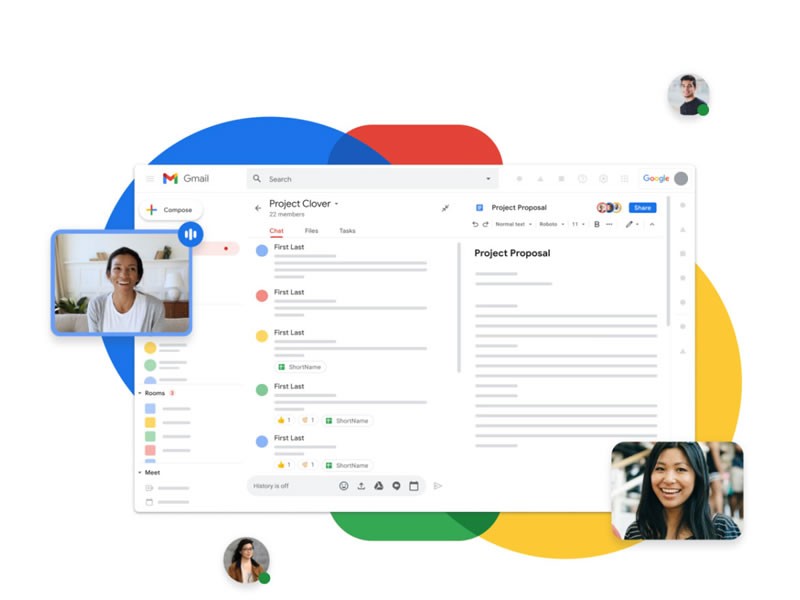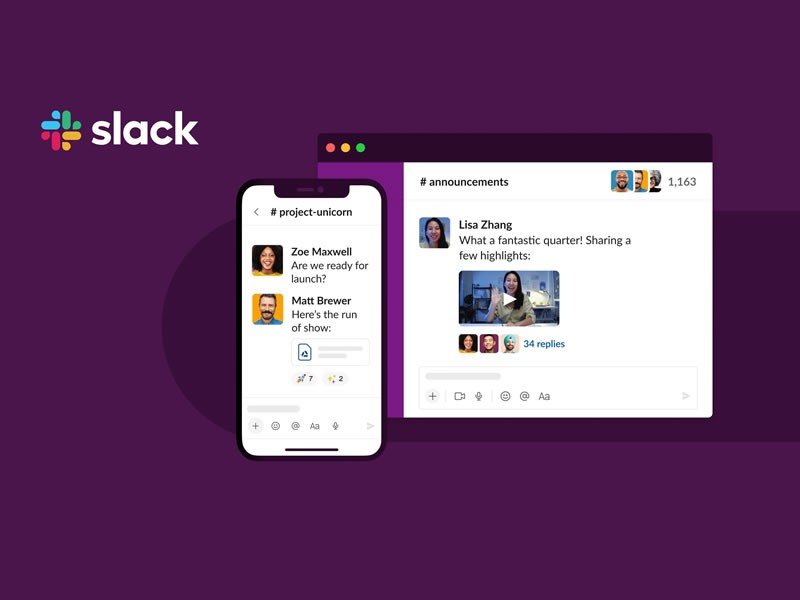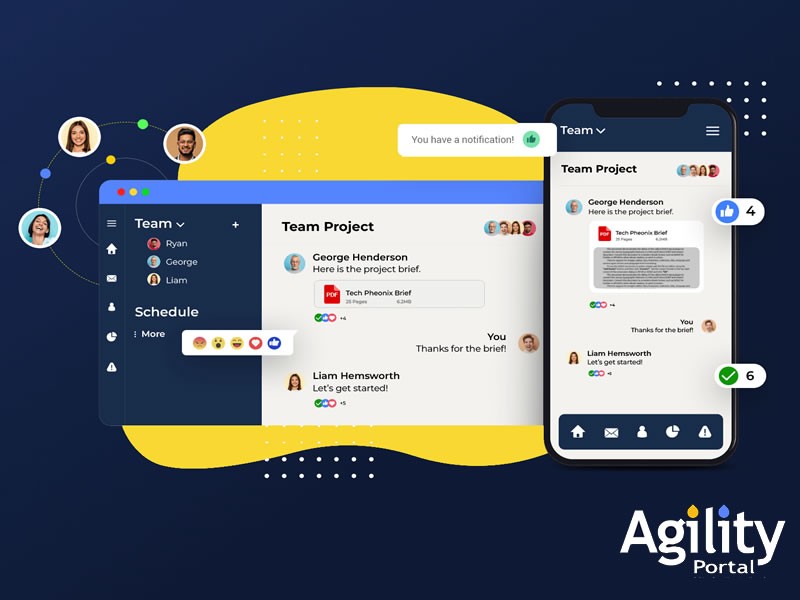Insight Blog
Agility’s perspectives on transforming the employee's experience throughout remote transformation using connected enterprise tools.
22 minutes reading time
(4337 words)
Best practices to kickstart your internal business communications strategy in 2023
What happens when you don't place importance on your internal communications? Avoid them using the best internal business communications strategy in 2023.
Your business cannot prosper without an internal business communication strategy.
Think about it. You have just made crucial changes to the operational systems. You have already explained it to the relevant stakeholders, and now the plan is ready. However, angry colleagues start sending you messages right after implementing changes. You may find it irritating, but it is a common internal communication problem in many businesses.
Thus, if you use the wrong internal comms strategy, the message will get lost somewhere in information overload, ignored, or completely forgotten. You should give the same importance to the internal comms strategy as you give to the recruitment communications strategy, customers, and partnerships.
This article will cover some of the most critical factors for creating an effective internal communications strategy for your business. We will discuss best practices, conducting a communication audit, setting goals, creating a communication strategy, selecting the most effective channels and tools, employee training, setting up monitoring and evaluation mechanisms, and more.
As you read this article, remember that it is intended to guide launching your internal business communication strategy and generating better business outcomes.
Assess your current internal communications strategy
A thorough evaluation of the current corporate communications is necessary before moving further with its development.
You'll gain insight into your current situation and the next steps you should take to reach your goals.
Here is what you can do to evaluate your existing internal communication strategy.
Identify communication gaps in your internal communications strategy
To evaluate internal communications initiatives, it's important to identify communication gaps by gathering employee feedback through surveys or one-on-ones, examining communication metrics, observing communication in action, and considering the strategy's alignment with long-term business objectives.
Here are some workplace communication benefits:
- Less misunderstandings
- Improved productivity
- More collaboration
- Increase in knowledge sharing
- Better company moral
- Higher employee engagement
- Stronger employee job satisfaction
- Overall better employee experience
- Better sales and business results
An internal communications audit is necessary to identify areas that need improvement.
Conducting an internal communication audit
A good internal communications strategy cannot be completed without an audit. Effective communication is the bedrock of any prosperous business. Organizations need a clear and successful communication strategy in today's fast-paced, information-driven society.
The first step in creating such a strategy is conducting a communication audit. It entails taking stock of the present state of communication within an organization and noting where changes could be made.
Each step in a communication audit is essential to create a well-rounded strategy of action for spreading your message.
Step #1
An effective internal communication audit begins with the detection of informational voids. To accomplish this, you can conduct surveys or arrange focus groups with your employees and other relevant stakeholders to collect their views. If you want to pinpoint where there is a communication breakdown, for example, with regard to information flow, message clarity, or timeliness, it is crucial to have a firm grasp on the preferences and needs of the various parties involved.
Step #2
The second part of an internal communication audit involves looking at the methods and platforms already in use inside the company. This covers the Internet, intranet, and social media. Analyzing how well and efficiently these routes of communication function is crucial. Metrics like response times, open rates, and click-through rates can reveal a lot about how well communication channels function.
Step #3
Step three of an internal communication audit assesses the efficacy of the existing communication resources and methods. The current methods of communication must be evaluated to see if they are adequate for achieving organizational goals and employees' needs. The introduction of new channels or technologies, or the enhancement of current ones, is crucial.
Step #4
Following an assessment of available internal communications tools and channels, it is important to set concrete goals and targets for this endeavor. The first step is to determine the goals of the organization's communication strategy. It is essential to the effectiveness of the communication strategy to establish measurable goals and objectives, such as enhanced engagement or improved collaboration.
Step #5
After deciding what you want to say, the next stage in crafting your internal communication strategy is to figure out to who you want to say it. It is crucial to determine your internal audiences and what information they require. This involves figuring out how to modify your message and delivery method based on who you're talking to.
Step #6
One of the most important parts of crafting an effective internal communication strategy is zeroing in on the most important ideas to convey. The first step is to identify the most crucial messages that need to be sent, and the second is to determine the most effective tone and language to convey those messages.
Step #7
An internal communication strategy is the result of an internal communication audit's last phase. The objectives, target groups, channels, and messages of the communication strategy should all be spelled out in this document. In addition to establishing a calendar for communication operations, a communication strategy should also define the communication team and assign responsibilities.
Thus, the first step in creating a successful communication strategy is undertaking a communication audit. An organization can develop an effective internal communication strategy that serves its employee's and management's needs by identifying communication gaps, evaluating internal communications tools and channels, defining goals and objectives, and finally, making a communication strategy.
Evaluating internal communication tools and channels
Assessing the various means of communication is crucial to any communication audit. To effectively disseminate information within an organization, it is necessary to have a reliable internal communications platform. Evaluating the efficacy of the existing tools and channels, and deciding whether or not to introduce new ones, are both parts of the review process.
●Ease of use is an important criterion to consider while assessing various communication forms. Employees are more likely to use readily available, simple-to-navigate, intuitive tools and channels. Each tool or channel must be assessed regarding its user interface, navigation, and functionality to see if it is up to par with employees and the business requirements.
●The safety of the used resources and communication methods should also be considered. The security of the communication tools and channels is paramount, as sensitive information may be exchanged through them. Checking the authentication and encryption of users and data can assist in establishing the safety of the used resources.
●Additionally, the tools' and channels' scalability should be assessed. It is crucial for a growing company to evaluate its current communication tools and channels to ensure it can keep up with its changing needs as it expands. It's important to consider whether or not the tools and channels can cope with a rise in users, data, and traffic volume.
●The efficiency of each method or medium should be factored into the overall assessment. Response and open rates, as well as levels of engagement, can shed light on the efficacy of the resources and methods used. This might aid in figuring out which channels and tools are best for the organization's communication needs.
Considerable time and effort should be spent assessing the various channels and methods of communication available before settling on a final plan of action. Each tool or channel must be evaluated based on its usability, security, scalability, cost, and performance to determine if it satisfies the requirements of employees and the business.
The evaluation process can point out where changes are needed and help direct the selection of new tools and channels that better serve the organization's internal communication needs.
Define goals and objectives for your internal business communications strategy
Planning is essential for an effective internal business communication strategy. You can't just leave everything to luck in this aspect of your business. Your messages will fall flat unless you invest much time and thought into crafting them. A practical method of reaching out to an organization's employees is essential for every business. It can also result in higher employee engagement.
Likewise, an efficient method of internal communication relies heavily on establishing well-defined goals and objectives.
●The first step is to establish your goals. Therefore, the first stage in developing a plan for internal communication is determining the outcomes you seek. These goals may include fostering a more enthusiastic workforce, facilitating teamwork, boosting output, fostering open communication, or establishing a solid corporate identity.
●Next, you need to identify your target audience. Prioritizing your target audience is a crucial first step in developing a solid internal communication strategy. The workforce as a whole, or only certain groups or units, may be involved. Knowing who you're trying to reach will help you select the best methods of distribution and craft messages that are more likely to resonate with them.
●Once you know your end game and who you're trying to reach, you can start crafting messages that will help you succeed. The messages should be easy to read and understand, as well as pertinent to the employees who will be receiving them.
●You should now concentrate on developing a strategy for communication. You can develop your communication strategy by establishing your desired outcomes, intended audience, and primary messages. The channels and methods you'll use to contact your employees, along with a timeframe and assigned duties, should all be outlined in this plan.
If you have well-defined goals and objectives for your internal communication strategy, you can rest assured that your messages will be timely, relevant, and helpful in attaining those goals.
4 of the best intranet software for sending company information and company news
Internal communication is important in the workplace as it increases employee engagement, builds stronger teams, shows a clearer picture of the organization's goals and objectives, and reduces conflicts.
The functions of internal communications include keeping employees informed, building company culture, promoting transparent leadership, enabling the exchange of information and ideas, and giving employees a voice within their organization.
Doing internal communications right can lead to happy, effective, and productive employees, here are 4 useful platforms for internal comms.
#1.Google Workspace, Best for Companies that use Google tools
Google Workspace is a secure collaboration and productivity app for businesses of all sizes, offering features like Gmail, Drive, Meet, and more.1It is a collection of cloud computing, productivity and collaboration tools, software and products developed and marketed by Google. All plans come with a free 14-day trial, and businesses can sign up for the Google Workspace newsletter to stay up to date with the latest stories, events, and products. Google Workspace also provides resources such as the Learning Center, admin help, and a newsletter to keep users informed and engaged.
- Screen sharing and file sharing
- Cloud-based platform, so all your data, updates, and information are automatically saved
- Easy sharing between different apps
- Can work on all devices
- Integrated chat, video calling, and screen sharing
- Professional email with predictive text
- Real-time collaboration on sheets, documents, and slides, with all version histories automatically saved
#2.Slack, Best for Real-Time Messaging
Slack is a messaging app for business that connects people to the information they need, allowing teams to work together as one unified unit.1It is designed to improve communication and collaboration within organizations, making it easier to access and share information. Slack also provides tools to help teams stay organized and on track with their projects.
- Instant messaging
- Integrated voice and video calling
- Messages can be scheduled to send according to date and time
- Can work on any device
- Unlimited custom channels to group conversations
- Integrations with other apps
- Unlimited searchable history
#3.SnapComms, Best for Time-Sensitive Messages
SnapComms is an employee communication software designed to help teams in organizations communicate more effectively. It provides features such as message scheduling, message targeting, and analytics to help teams better understand their communication efforts. It also offers a range of communication channels, including email, desktop alerts, and mobile notifications, to ensure that messages reach their intended audience. SnapComms also provides a library of customizable content, such as videos, images, and surveys, to help teams create engaging messages.
- Multi-device display that lets messages be seen on any screen
- Built-in screen reader that displays messages in different ways
- Real-time reporting dashboard that shows employee readership and engagement
- Targeted messages
- Scheduling feature that lets you decide when a message should be sent out
#4.AgilityPortal, Best for Cross-department Collaboration
AgilityPortal is a cloud intranet out-of-the-box solution that comes with preconfigured settings and modules, ready in minutes and does not require any technical IT knowledge or skills. It is a powerful employee intranet that helps businesses improve internal communication and create a culture of workplace. It also allows users to add different teams, departments, and office locations, as well as provide a client and supplier portal for external collaborators. Comes with a 14 day trial.
- Recognition system for relaying workplace achievements
- Gamification and leaning features
- Engaging social platform for the company
- Send important comms using announcement add-ons
- Multi-device, on a laptop, desktop or mobile
- Noticeboard for employees to leave messages
- Chat and broadcast messages
Defining target audiences for internal communication strategy
Identifying your audience is one of the most critical aspects of developing a successful plan for internal communication.
Recognizing and learning about the many subsets of the organization receiving the message is a crucial first step.
Consider work positions, frontline employees, departments, locations, demographics, and communication preferences, among other things, to establish target audiences for an internal communication plan within an organization. These considerations can guide the development of targeted messages and routes of dissemination.
Developing detailed profiles of your target demographic that highlight their unique traits and information requirements is one strategy. Such an approach can assist in making current internal communications more likely to be understood and appreciated by their targets.
Also, as the company develops and changes, the profiles of its intended readers should undergo periodic reviews and revisions. This can help maintain the strategy's efficacy and continued applicability for all involved parties inside the organization.
Identifying key messages for internal communication strategy
To ensure that the intended audience receives the most relevant and beneficial information, it is vital to identify key messages for an internal communication plan.
Find out why you're writing or speaking and what you want to accomplish. This will ensure that the most crucial information is conveyed in each message.
Similarly, you should know your audience's wants, fears, and other sentiments. As a result, you can make sure the content is interesting and engaging for them. Use language that is simple, direct, and straightforward.
When writing for a particular group of people or delivering a specific message, it's essential to strike the right tone.
Furthermore, you must determine which details must be relayed to the audience with the utmost urgency and give them the attention they deserve in the messages.
Think about the best methods of reaching your target audience, such as email, the intranet, video, or in-person meetings. Try using a few different internal channels to maximize the likelihood of your messages being received.
Last but not least, go over the main points with a select group of employees or stakeholders to get their thoughts and double-check that everything is as clear, accurate, and pertinent as possible.
By adhering to these guidelines, you'll be able to create an internal communications strategy with targeted messaging and guarantee that those communications are delivered in a way that resonates with your target audience.
Develop a communication plan for an internal business communication strategy
A specific procedure must be followed when creating an internal communication strategy. The first step in any successful communication strategy is clearly articulating your desired outcomes.
This may involve a variety of goals, including raising awareness of a new program, boosting participation among employees, or spreading crucial data.
After deciding what you hope to accomplish through your internal communications, you must decide about who you're speaking to. Tailoring one's message to an audience's specific requirements, tastes, and way of communicating is essential.
The next step is to determine the best means of distribution to reach this audience. Depending on who you're talking to and what you want to say, you might choose to do this via email, an intranet, social media, video, or even in-person meetings. It is necessary to employ several channels to maximize message delivery likelihood.
Formulating a coherent message approach is integral to any successful communication strategy.
For this purpose, crafting messages that align with the communication objectives and expressing these messages in a straightforward language is necessary. The tone of the messages must be suitable for the intended receivers and the content being communicated.
Lastly, it's crucial to assess how well the communication strategy works and make any necessary improvements frequently.
Identifying communication team and roles for internal communication strategy
It is important to figure out who will be communicating and their specific tasks. You should consider the following factors as you go through this procedure.
●It may be necessary to hire a full-time internal communications team or divide up the work among current employees, depending on the organization's scope and the communication plan's intricacy.
●To ensure that the communication team members cooperate efficiently, it is essential to establish their specific roles. Positions like project manager, content creator, graphic designer, social media expert, and event coordinator are all examples.
●Since different employees from the communication team will be tasked with different tasks, it's crucial that everyone on the team be well-equipped to handle their responsibilities. A content creator, for instance, may benefit from polished writing and editing chops, while a graphic designer might benefit from familiarity with design software.
●Stakeholders, such as department heads or upper management, should be identified and added to the communication team. To keep them involved and informed, it's crucial to spell out their specific tasks and duties in the communication strategy.
●Create a streamlined process for employees to follow in terms of communicating updates, milestones, and deadlines. As a result, the team can better collaborate and adhere to the timeframe for developing the communication plan.
This can help you determine who needs to be on the communication team and their specific responsibilities to implement a successful internal communication strategy.
Choose communication channels and tools for internal communications
Choosing the right channels and tools for internal communications strategy involves key steps. First, it is important to understand the preferences and habits of the intended audience to determine the most effective channels and tools.
More importantly, you need to analyze staff communication. Evaluating staff communication can help you to improve internal communications.
Different types of messages may also require different channels and tools depending on the purpose, urgency, and nature of the information being communicated.
It is also essential to use multiple channels and tools to reach employees and ensure that the message is received effectively. This could include email, intranet, social media, instant messaging, or face-to-face meetings.
Keep in mind that one way communication can ruin your efforts to improve internal communications. So, you can try to change communications channels.
Additionally, it is important to regularly test and evaluate the chosen channels and tools' effectiveness to ensure that they reach the right employees and achieve the communication goals.
By following these steps, an organization can select the most appropriate channels and tools for its communication strategy and ensure that the intended audience receives the messages promptly and effectively.
Intranet for internal communications strategy
With an intranet, employees have one convenient location to access company-wide documents like policies and procedures.
Furthermore, customizing an intranet allows for the dissemination of information about company activities, the distribution of information, and the management of projects and files.
Moreover, an intranet provides a safe space for sensitive data and can be managed by IT to ensure appropriate access and permissions are applied. This is paramount for businesses that handle financially, legally or medically sensitive data.
In addition, an intranet facilitates unified company-wide communication with employees, making it possible to disseminate information and keep all employees abreast of developments.
Improved employee engagement and happiness can result from this, along with higher production levels, efficiency, and cooperation. An intranet can also improve employee communications. Employee communications are a major focus of intranet portals as they can result in higher engagement.
Because it provides a single, safe, and standardized location for employee communications, the intranet is indispensable to any successful internal communication strategy.
Train employees for internal communications strategy and make sure all employees are on the same page
Internal business communications can be strengthened by providing employees with communication training. Focus on employee communication enhances employees' ability to share information, work together productively, and form positive working relationships when they have better communication skills.
Better employee communication has the potential to improve morale and productivity in the workplace. To maximize the training's impact, it must be designed for the organization's unique requirements and supported throughout the time.
Role of employee engagement in internal communications strategy
Employee engagement is important for any internal communications strategy because it facilitates trust, opens lines of communication, and creates a healthy culture within an organization. Improved productivity, lower turnover, and more positive organizational results can result in more engaged employees.
Opportunities for feedback, appreciation, collaboration and clear and consistent messaging from leadership are all examples of internal communications tactics that may increase the buy-in and loyalty of employees. Therefore, you should consider employees in every step of your strategy.
Encouraging employee feedback and participation
A good internal communications strategy should focus on the employees. It can empower employees of your organization. Getting feedback is one of the most important parts of any successful internal communications plan. They are more invested, driven, and dedicated to their jobs when they believe their opinions matter and are being heard. The internal communicator can be crucial in making an internal comms strategy successful. He can help in engaging employees by using different methods.
Organizations can use surveys, suggestion boxes, town hall meetings, and employee focus groups to boostthe input of employees. It's crucial to update employees on the outcomes of these initiatives and demonstrate how their comments were taken into account in future decisions. It can also affect employee performance and employee experience.
Equally important is creating an environment where employees feel comfortable speaking their minds and receiving constructive feedback. Most employees complain about bad employee experience. So, keep things simple and make the messages easy to understand. Providing straightforward instructions can help to boost employee experience.
Likewise, two way communication can help to improve the employee experience. You should also facilitate the internal communicator as he can help the employees. Moreover, employees understand the importance of a communications platform and its role in collaboration.
So, you should encourage employees to get training to improve their communication skills. It can also boost employee advocacy. Employee advocacy is the promotion of your organization. It helps improve public relations and brand building.
Measuring the effectiveness of your communication strategy
For your communication strategy to be successful and to learn where it can be improved, you must first assess how well it is performing.
The key to success is following a well-thought-out plan of action. You need to keep an eye on key performance indicators.
The first step in developing an effective communication strategy is articulating your desired outcomes. Having a clear goal before any measuring project is a good way to avoid wasting time and energy.
Second, you should set targets using metrics relevant to your aims. Metrics like employee satisfaction surveys, turnover rates, and morale indexes can all help gauge progress toward increasing employee engagement.
The third stage to monitor development over time is gathering data and consistently measuring your metrics. Methods like surveys, focus groups, and other feedback systems can be used for this purpose.
Next, you'll want to analyze your data to determine what's working and isn't after you've collected it. This will allow you to track your progress and make adjustments as needed.
Last but not least, it is crucial to modify and improve your communication strategy based on the findings of your investigation.
Constantly monitoring and changing your strategy will guarantee that it will yield positive results over time, allowing you to realize your dreams finally.
Role of internal communicators in internal communications initiatives
Internal communicators are responsible for developing and implementing strategies and tactics that will guarantee employees receive consistent, accurate, and timely information.
Internal communicators mediate between management and employees, boosting morale, productivity, and morale in the workplace.
Internal communicators should also be familiar with the many channels and technologies that may be utilized to reach employees effectively.
They should also be adept at developing messages targeted to the needs and preferences of different employee groups. In addition, the internal communicators should evaluate the internal communications strategy regularly to ensure it is still relevant and effective.
Wrapping up
The growth of any organization depends on its employees' ability to communicate effectively within the company.
You may provide the groundwork for efficient internal communication by adopting the aforementioned best practices, such as establishing clear goals and objectives, utilizing a variety of channels, encouraging open and transparent communication, and periodically assessing and adapting your strategy.
A more productive and positive work environment results from an organization that values and encourages open lines of communication among its employees.
Keeping these tips in mind is a great way to get your internal communication plan off the ground and make your workplace a better place for everyone to work.
Categories
Blog
(2601)
Business Management
(319)
Employee Engagement
(211)
Digital Transformation
(174)
Growth
(119)
Intranets
(111)
Remote Work
(61)
Sales
(48)
Collaboration
(36)
Project management
(29)
Culture
(28)
Customer Experience
(26)
Knowledge Management
(21)
Leadership
(20)
Comparisons
(6)
News
(1)
Ready to learn more? 👍
One platform to optimize, manage and track all of your teams. Your new digital workplace is a click away. 🚀
Free for 14 days, no credit card required.






















